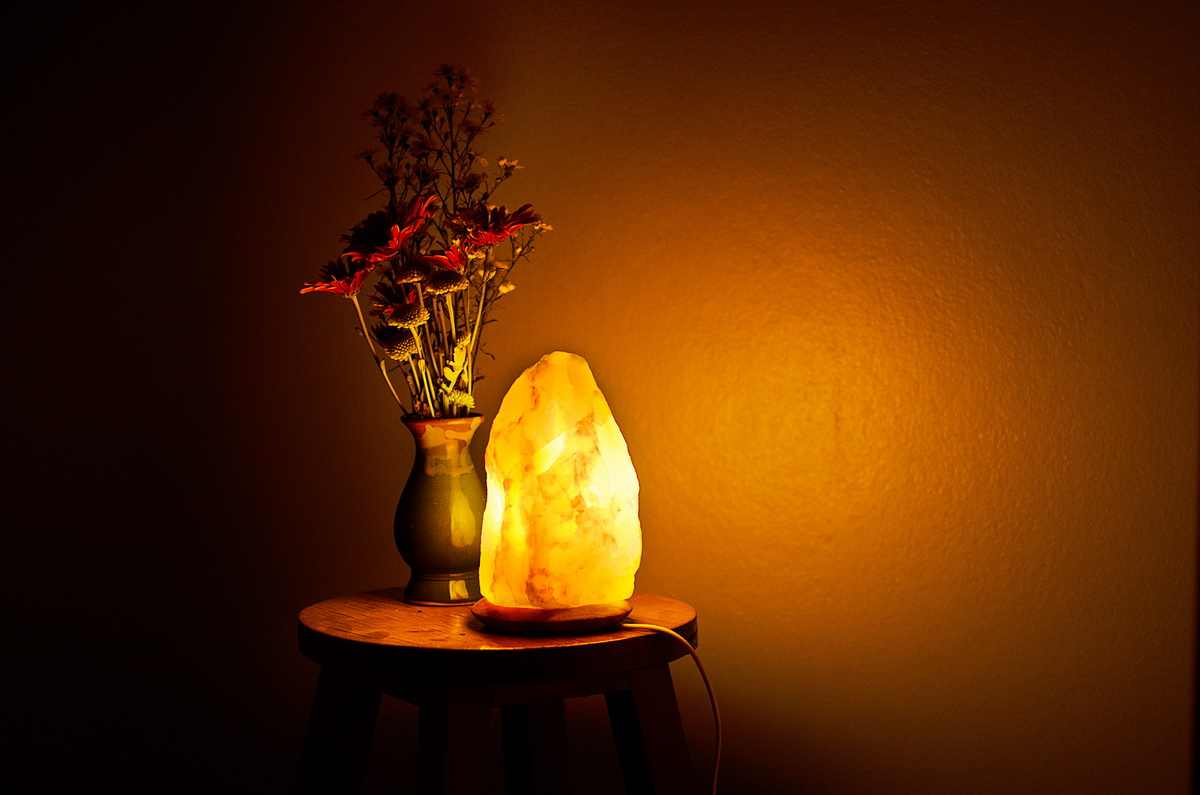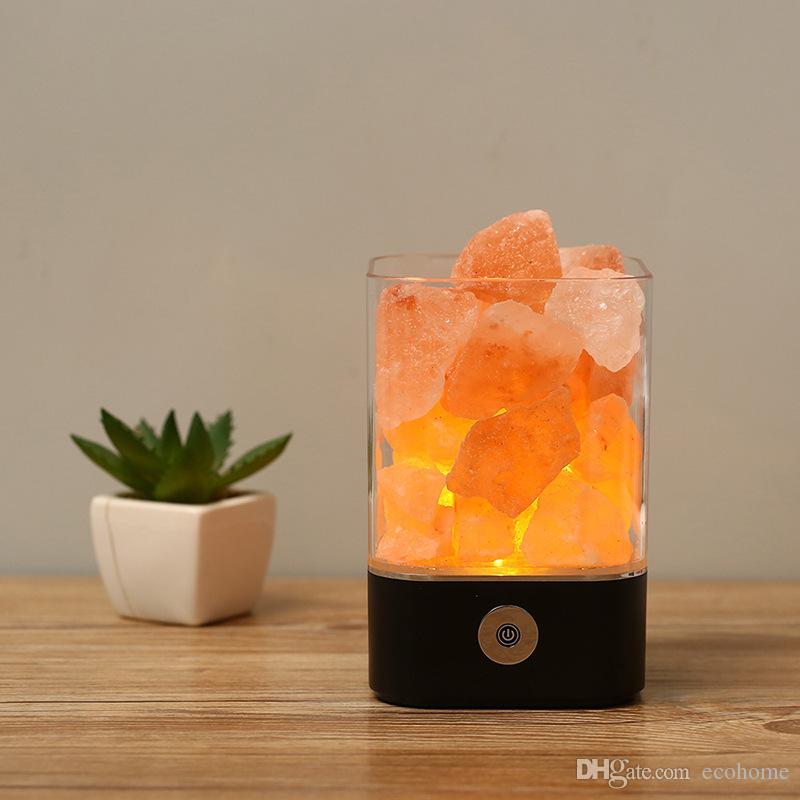
If you are thinking about buying a salt lamp, before adding anything to your home it’s important to weigh out the pros and cons of Himalayan salt lamps. Himalayan salt lamps are large crystals of reddish-hued salt that have been chiseled out in the center to place a light bulb or heat lamp.
They originate from deep underground mines on the western edge of the Himalayan Mountains in Pakistan. The Himalayan Mountains are the only source of true Himalayan pink salt. The color of Himalayan salt lamps ranges from a light pink to a pinkish orange with the hue a result of the mineral concentration (1).
While they make attractive pieces for any room in your home, these pink illuminative lamps are more than just decorative night lights. The pros and cons of Himalayan salt lamps should be properly examined. Himalayan salt lamps are claimed to host an array of health and environmental benefits which make them very beneficial for the home. When warmed, they release negative ions that are said to cleanse the air and energize you. Salt crystals absorb moisture from the air and by attracting water particles they produce the negative ions (2).
This water vapor can be pulled in by Himalayan salt lamps also carry indoor air pollutants like mold, bacteria, and allergens. Once the water vapor comes in contact with the salt lamp, the pollutants are believed to remain trapped in the salt. The salt lamp never loses its ability to do this process since the lamp is heated. When the Himalayan salt lamp dries out it continues the cycle of attracting water vapor and pollutants, releasing the water vapor back into the air but holding on to the health-hazardous pollutants (3).
With all of its benefits, it’s easy to see why Himalayan salt lamps are the latest trends but are they worth it?
Pros and Cons of Himalayan Salt Lamps
Pros:
1. Purifies the air
Indoor air pollution has the same negative effects as environmental pollution. Gases or particles that are released into the air from a variety of sources can decrease the quality of our indoor air. This pollution can range from harmless to irritating to downright deadly. Poor indoor air quality can cause or contribute to the development of infections, lung cancer and chronic lung diseases such as asthma. Himalayan salt lamps are claimed to help remove dust and pollution from the air with negative ions (4). These ions have been shown to cling to dust to make filtration or clean up easier.
2. Reduce asthma and allergy symptoms
Asthma and allergy control begins at home. Allergic asthma is triggered by inhaled allergens such as dust mites, pet dander, pollen, mold, etc. Since Himalayan salt lamps purify and remove particles of dust, pet dander, mold, mildew from the air having Himalayan salt lamps can help cut back on asthma and allergy symptoms (5).
3. Boosts Energy
Allowing more energy to flow through your body can increase your ability to skillfully deal with stress, increasing your overall well-being. One of the pros of a Himalayan salt lamp is it can boost your energy. It helps get rid of ions that block the flow of energy. Positive ions can drain your body of energy Himalayan salt lamps’ negative ions help revive the body and mind.

4. Reduces Stress and Boosts Mood
When negative ions reach the bloodstream, they are said to produce reactions that increase serotonin, a chemical that helps to alleviate depression, relieve stress, and boost daytime energy. The impact of negative ions on your body, which improves oxygen and blood supply to the brain and other body organs and boosts your serotonin levels, thus making you feel happy.
5. Reduces Electromagnetic Radiation
We are embedded in a vast sea of electromagnetic (EM) radiation emitted by our electronics (smart phone, computer, television, tablet, appliances, etc). Constant exposure to EM radiation is known to increase stress levels, cause chronic fatigue, and decrease the body’s immune response, among other things. Negative ions will certainly cancel out positive ions and perhaps reduce harmful side effects of our gadget-focused lifestyle.
6. Improves Sleep/Excellent Night Lamp
They emit light that doesn’t disturb sleep hormones and as the light is typically quite dim and warm, this makes them perfect nightlights. According to color therapy warm pinkish to orange colors like the glow of the salt lamp is a calming and happy presence in a room and the release of negative ions into the air can help reduce anxiety and also encourage a relaxing atmosphere for sleep (6).
Cons:
With everything, there is a good and bad side. Now we will quickly share the cons of Himalayan salt lamps
7. Known to Have Leak Issues/Sweat
When the humidity level in a room is higher than normal, the salt will absorb the moisture from the atmosphere and small pools of water can form underneath. Ruining furniture.
8. Many Counterfeits on the Market
With the popularity of Himalayan salt lamps many manufacturers are releasing counterfeits. Unfortunately, some of these characteristics will only be made known to you if you read reviews very carefully or, the less desirable scenario, once you’ve been actually using it in your home for a while (so hang on to that receipt!). While it is hard to spot a counterfeit if the price is very low that may mean that it’s fake. Due to its high content of numerous minerals, a Himalayan salt lamp gives off light in an irregular and muffled manner (7). A true salt lamp does not give off enough light to completely illuminate a room. If yours does, then it’s most likely not the real deal.
9. Can Easily Break
Minerals reinforce the salt crystals; without them, the crystals are brittle and can shatter. White salt lamps are often marketed as those with the purest vibrations, but beware — they are also the most fragile. Please note that there is such a thing as a white Himalayan salt lamp, but it’s extremely rare and a lot more pricey than the colored ones. So if you find a white salt crystal lamp that’s not substantially more expensive than the pink/orange versions, steer clear because this is likely an imposter.
10. Salt Is Corrosive
As mentioned above a con of Himalayan salt lamps are the fact that they are known to leak or sweat (8). As a lamp sweats, salt-laden water collects around the base and corrodes whatever surface the upon which the lamp is resting. If the surface is metal, it will quickly rust.
11. Salt Lamps Are Heavy
Salt lamps range in weight from 5 to over 50 pounds, and generally, the heavier a lamp is, the more expensive it is. And as mentioned above if the lamp is inexpensive their is a high chance that it is a counterfeit Himalayan salt lamp
Key Factors To Consider When Buying A Himalayan Salt Lamp:
Authenticity – Make sure you are getting a real salt lamp and not a cheap imitation. Natural, authentic Himalayan pink salt is actually flesh-colored and not peach or peach-orange (like most cheap imitations). You can tell the difference by simply touching it with your hand. Authentic halite lamps also have solidified ‘clumps’ of salt attached to their base; they will appear whitish/opaque rather than clear like glass (see photo below). Although solidified pieces that look opaque (a whitish/grey color) may be more common in USA stores they’re still considered fake as this solidification is a result of the rock being heated in an outdoor kiln for 24+ hours. If your salt lamp doesn’t have natural solidified chunks attached to its base then it’s not an authentic Himalayan pink salt lamp. If it has been heated before the rock was mined then it’s fake. Habitat – Authentic Himalayan pink salt lamps come from, you guessed it, the Himalayas! Make sure your salt lamp is authentic and not a product of China.
Energies & Colors – As previously mentioned, authentic Himalayan salt lamps emit a range of beautiful colors that are not only aesthetically pleasing but benefit your health. Natural pink Himalayan salt lamps emit a red/pinkish-orange color due to the ratio of magnesium (Mg) and sodium (Na) ions in each crystal, whereas other colors such as red, orange, yellow, purple, blue, green are created by trace elements of other minerals. All salt crystals will have a pinkish hue, however, there are some that have a more creamy white color with hints of orange which is due to the presence of sulfur in the rock. Authentic Himalayan salt lamps also emit negative ions while being turned on and additionally they emit infrared rays. Not all salt lamps produce negative ions and/or infrared rays, so it is important to be familiar with the product you’re buying.
Size – Larger salt lamps are better than smaller ones as they have a larger surface area to emit more negative ions into the air. The average weight of a 7-9 Lb authentic Himalayan pink salt lamp is usually between 4 and 6 inches wide by 4 to 6 inches tall. If it’s smaller, then you probably have a fake on your hands. Just like with anything else, the bigger the size of an authentic salt lamp the higher its value and price point.
Trace elements – Authentic Himalayan pink salt lamps are made up of more than just salt! Each rock contains several trace minerals which produce the different colors of your salt lamp; some cheap imitations may include artificial coloring to make them appear more aesthetically pleasing. If you’re looking for an authentic salt lamp then you want to be sure it’s made only of pure Himalayan pink salt and that it doesn’t contain any other additives or coloring.
Price – As a general rule, you get what you pay for. Himalayan salt lamps tend to range in price from $20–$200+ depending on their size and color. For example, a large pink salt lamp can cost around $100+, while small white or peach-colored salt lamps can be purchased for much less ($15-$30). On average, you can expect to spend between $20-30 for a decent-sized salt lamp.
Burning time – Natural Himalayan pink salt lamps vary in terms of their burn time, but on average they will last around 25-35 hours before you need to turn them over or replace the bulb. Make sure your salt lamp has an estimated burn time so you know how long it will last before you need to replace the bulb or turn it over. While there are salt lamps that have been tested for 100,000 hours of use, not all vendors give an estimated burn time so be sure to ask if it’s a concern of yours.
Environmental – If your intention is to reduce pollutants and improve air quality then you should be looking for salt lamps that are both Salt Cave approved and Himalayan Salt Shop qualified. Salt Lamps that are not made of 100% authentic Himalayan pink salt emit lower levels of negative ions, which means they’re less effective at purifying the air.
When it comes to evaluating the pros and cons of Himalayan salt lamps, take into consideration the size of the room in which you will keep your lamp in. The coverage of a Himalayan salt lamp is determined by the size of the salt crystal. On average, to effectively cleanse the air of a space, you need one pound of salt rock for every 16 square feet (four feet by four feet) area. If needed, you can always use multiple salt lamps spread out in a single room.
Want to improve the energy and mood in your home? Check out herbs to burn to clear your home of negative energy!